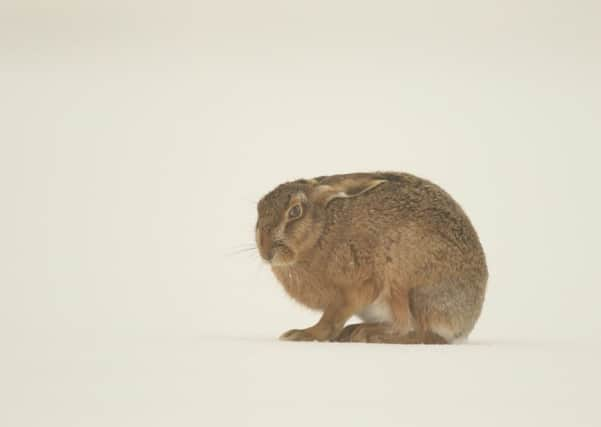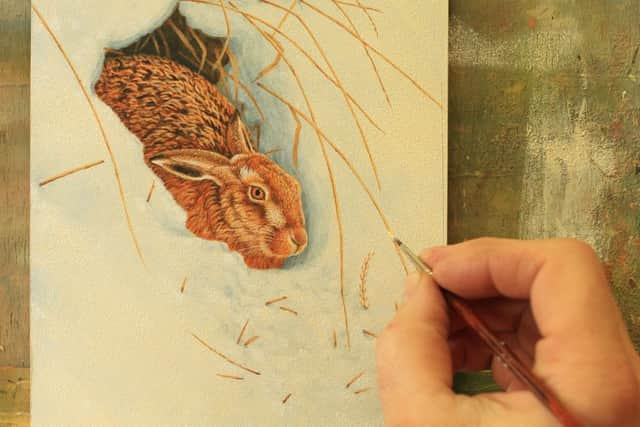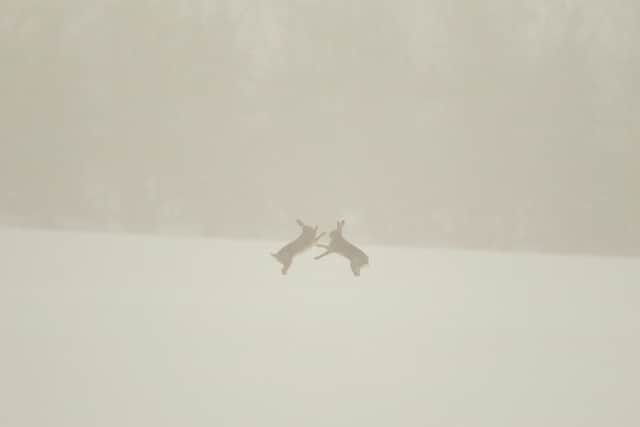Stealth tactics on the Wolds in pursuit of dramatic hare footage


But what a strange, warm, wet, windy winter it’s been. The bats have stayed on the wing, hedgehogs have barely bothered to hibernate, butterflies, blossom and daffodils have all made unusual appearances.
This was despite Met Office predictions last October for the coldest and most severe winter on record. The hype about this bitter forecast reached fever pitch when a Bewick’s swan made it onto the national news when it arrived from Siberia two weeks earlier than usual.
Advertisement
Hide AdAdvertisement
Hide AdAt the time, I was in a meeting in Bristol to discuss ideas for wildlife topics for The One Show.


The BBC1 series producer wanted my input for a new series of wildlife related pieces and I suggested a snow safari to look for owls, and hares. The plan was to show how hares breed and box all year round. The producers jumped at the idea and commissioned a four-and-a-half minute piece.
I came home and made preparations. In order to photograph wildlife up close it is important to blend into the background. I’ve had plenty of practice and have a few tricks up my sleeve: a snow white ski suit, a balaclava made out of a pillowcase, white oven gloves and tailored white covers to wrap around my camera and tripod.
All we needed now was snow. We had a flurry in November but it didn’t last. This was followed by so many wet and windy storms I was getting worried the Met Office, that was using the alphabet to give each storm a sequential name, would run out of letters.
Advertisement
Hide AdAdvertisement
Hide AdThen finally in January the snow came - enough for me to get some video footage of the hares before inviting the crew for the main shoot.


I drove to some fields where I often see hares and using binoculars I picked out a group of 30 hares, some of them actually boxing. I rang the landowner to get permission to film and then set off. I headed up a tram line, made by a tractor wheel, which took me directly towards the hares.
I wanted to get close enough to the hares to film them so I gradually walked closer, stopping whenever they showed signs of spotting me. After a couple of hours I was in photographing range of eight hares, frolicking in the snow.
I didn’t manage to film any boxing but I had shots of some chasing one another about and even a few spats. Then I heard a dog yapping. The hares flattened their ears and squatted to the ground. Some dashed off. Then a lurcher ran across the field in pursuit, followed by a yappy mongrel.
Advertisement
Hide AdAdvertisement
Hide AdWhen the dogs disappeared there wasn’t a hare in sight but after a while some of the buck hares came back looking for the does. They were very jumpy and soon dashed off again.


Disgruntled, I headed off to a different field where I spotted two more groups. I headed to the nearest.
I made my approach slowly and then out of nowhere a bank of fog rolled in. I couldn’t see a thing. I heard the faint call of a grey partridge. The sound got louder and then a ghostly partridge appeared out of the mist. I watched as its silhouette then faded into the fog. I tried to navigate by looking at my footsteps behind me.
Then, a hare burst out of a snow hole and dashed away from me. Finally my eye had something to focus on. The stray hare ran straight into the group of hares. They looked like ghosts in the distance, all standing to attention. I waited for them to settle before edging forward. Then suddenly they all ran away into the fog.
Advertisement
Hide AdAdvertisement
Hide AdI decided to try the other group. As I made my way across the field, I bumped in to a straggler. He ran down the field and disappeared into the whiteness. I then spotted the group. I had to tread carefully.


I was watching the hares all the time. Any twitch of an ear or tilt of a head and I would stop for as long as it took to settle back down.
Then I saw a buck try his luck with a female. He sniffed her but she hunkered further down into the snow. Another buck chased this rival off in a circle around the group. There were two females amongst them - I could tell by the obvious attention they got from the bucks and because they were slightly smaller with finer heads and paler fur than the more ginger bucks.
At last the fog began to clear. I watched the group for an hour. It was fascinating seeing the bucks jostle for position in the group and amusing to see how their antics did little to impress the females who continued to hunker down.
Advertisement
Hide AdAdvertisement
Hide AdI edged forward. Then without warning one of the females took flight, taking the bucks with her on a race across the field. She would only choose the fittest and strongest male to mate.
Then I saw her start to box. Snow and fur went flying as the pair fought it out, both standing bolt upright on their hind legs. Frustratingly they were too far away to film.
I had only just one female hare left in front of me now. I got down low on my hands and knees and crept closer until I was 12 metres away. She stayed in the same huddled position the whole time, like a compacted sculpture, then she got up and casually started eating her own droppings - not the dramatic film of boxing hares that I had envisaged, but it was interesting nonetheless.
VISITORS CAN SEE NATURE CLOSE UP
Visitors to Robert Fuller’s gallery at Fotherdale Farm in Thixendale on the Yorkshire Wolds are able to watch live footage from cameras planted in animal nests in his garden.
Advertisement
Hide AdAdvertisement
Hide AdAnd now that it is Spring, the nest boxes are becoming increasingly active, the wildlife artists reports.
“A pair of barn owls is trying one nest for size and should be laying soon, whilst a male tawny owl and male kestrel are trying to entice their mates into their respective boxes,” Mr Fuller said.
“A male and female weasel are both visiting the garden and can be seen sleeping in the nesting chamber or feeding in the tree top box.”
The gallery is open seven days a week, between 9.30am-4.30pm weekdays and 10.30am-4.30pm on weekends.